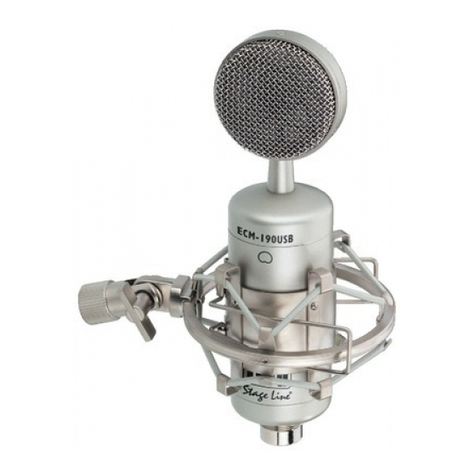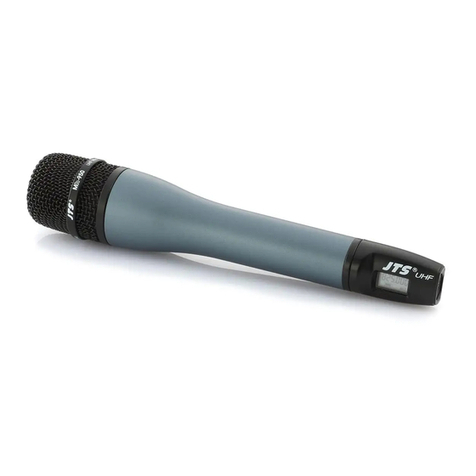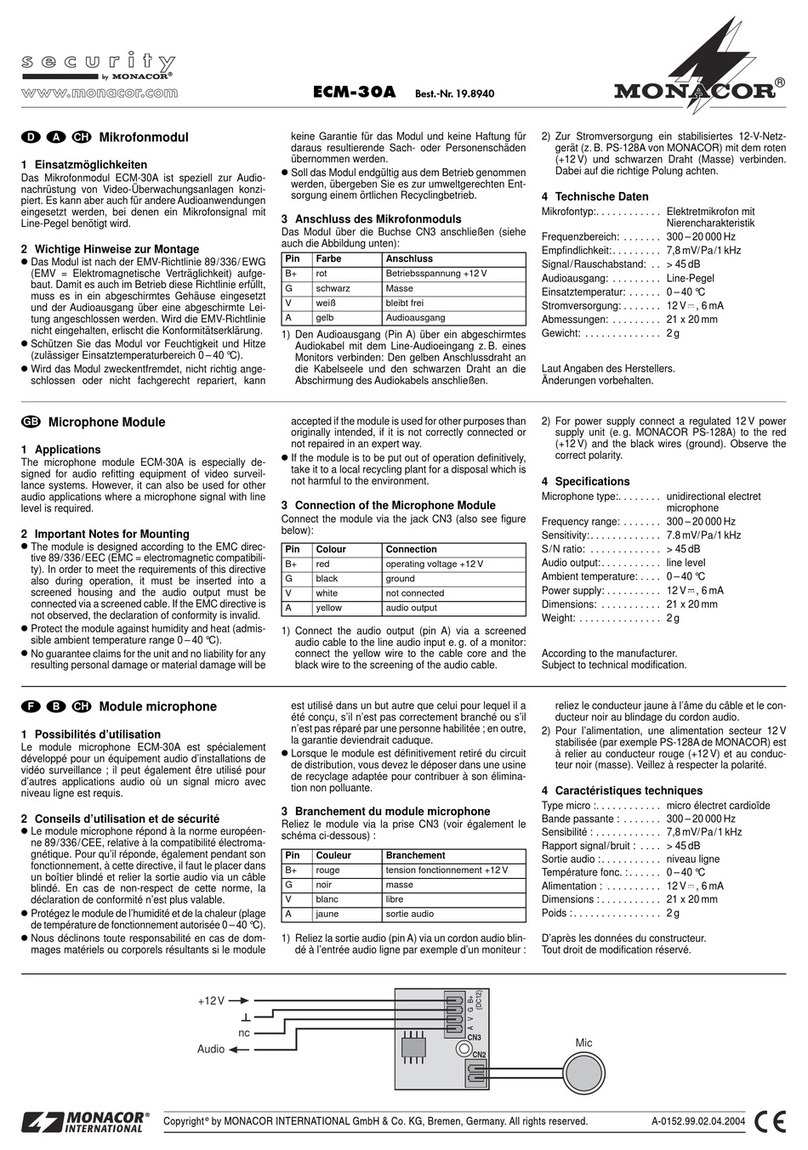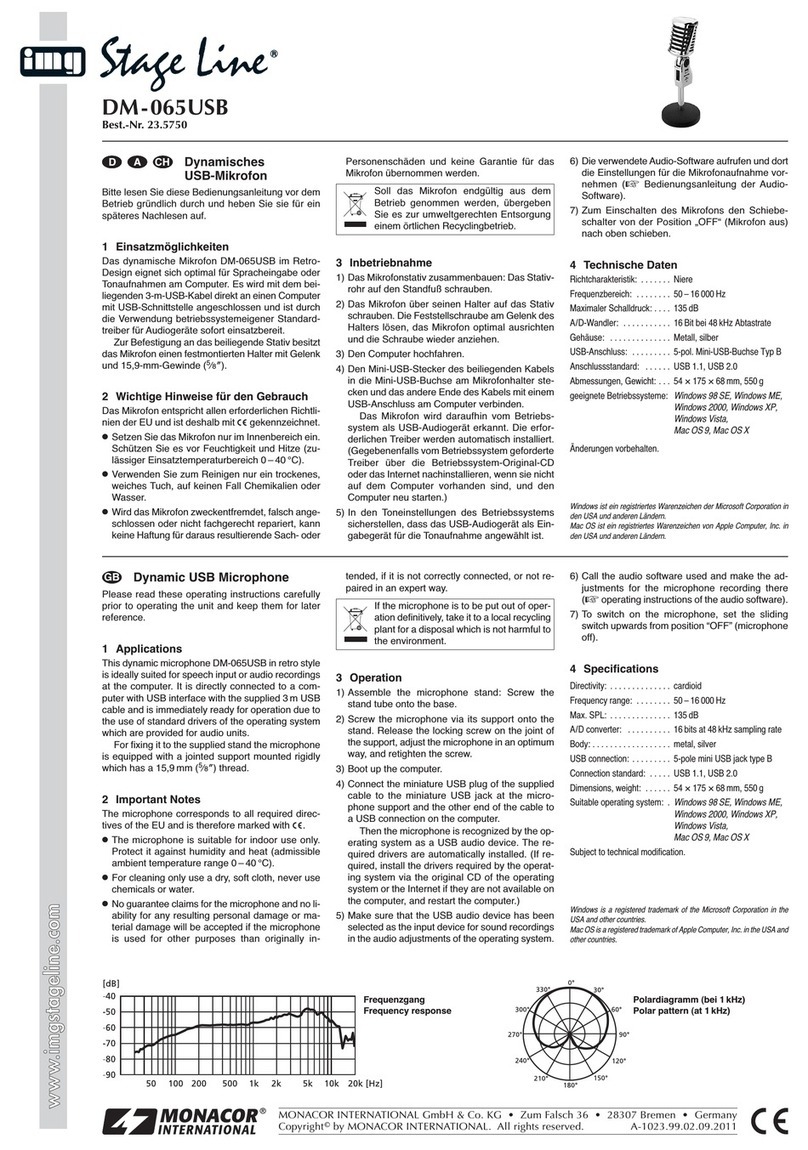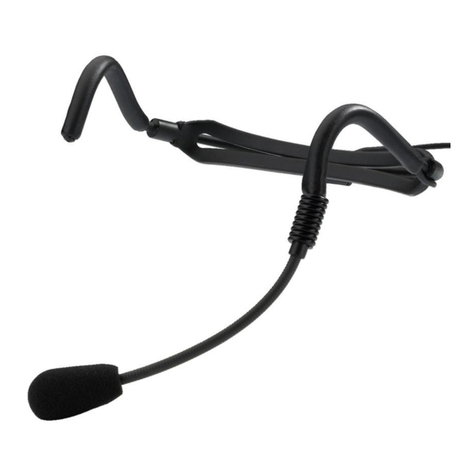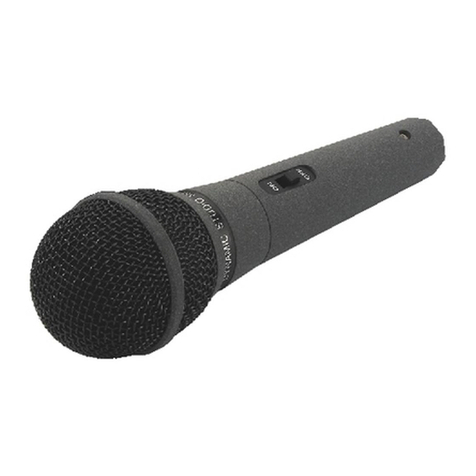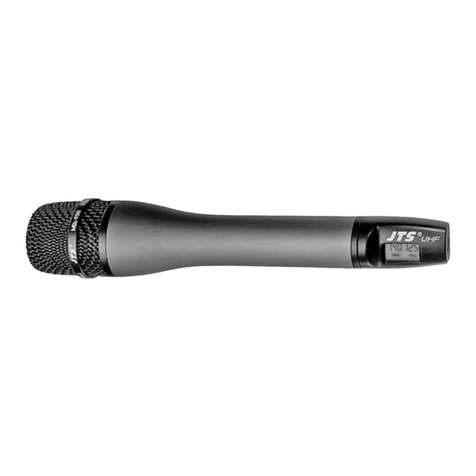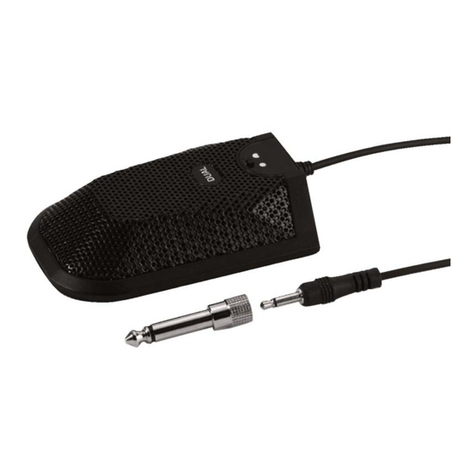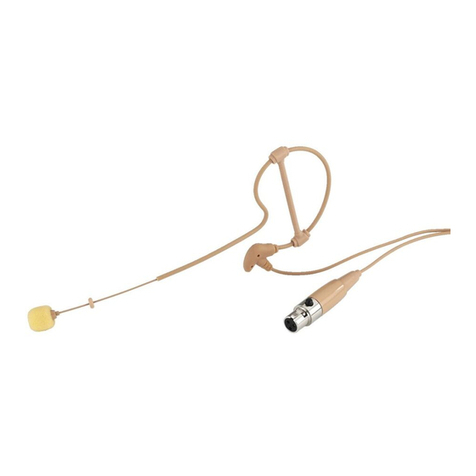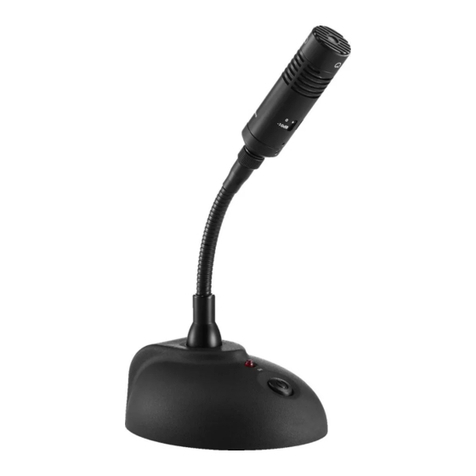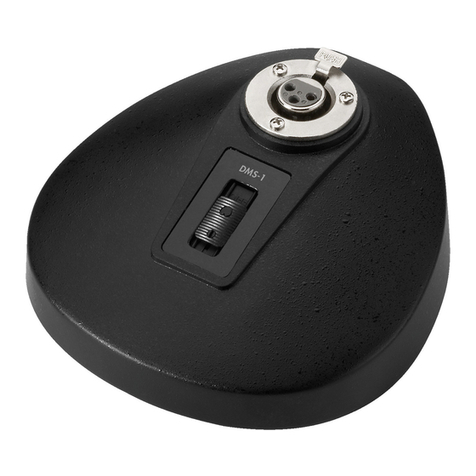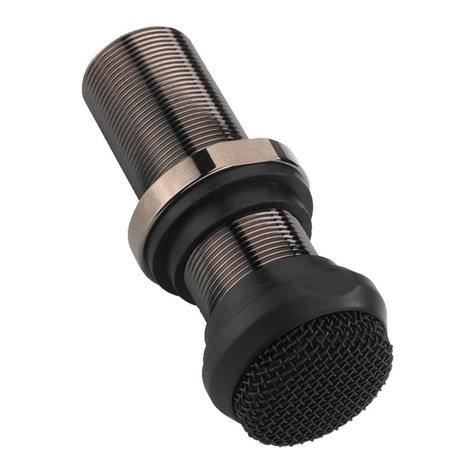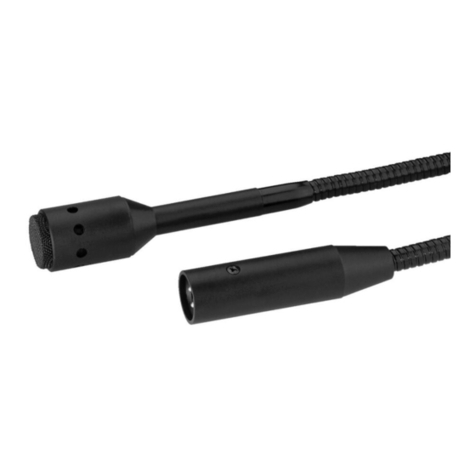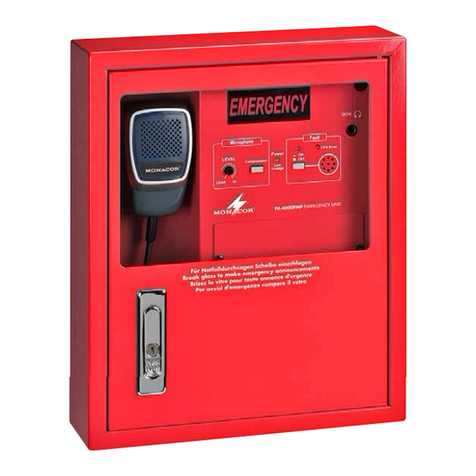ECM-130
Best.-Nr. 23.3580
wwwwww..iimmggssttaaggeelliinnee..ccoomm
Copyright©by MONACOR INTERNATIONAL GmbH & Co. KG, Bremen, Germany. All rights reserved. A-0430.99.01.06.2005
®
Large Diaphragm Electret
Microphone
1 Applications
The microphone ECM-130 with extra thin, gold-
coated diaphragm is designed for professional stu-
dio and live applications and is both suitable for the
sound pick-up of musical instruments and for vocal
sound and speech applications. The directivity can
be switched between unidirectional, bidirectional,
and omnidirectional. The microphone is operated
with a phantom power of 48V and has a switch-
able low cut filter and a 10dB attenuator switch.
The microphone is supplied with a lockable case
(including 2 keys), a vibration-dampening micro-
phonesupport(spider), a replacementribbonfor the
spider, a windshield, and a key for opening the
microphone.
2 Important Notes
The microphone corresponds to the directive for
electromagnetic compatibility 89/336/EEC.
●The microphone is only suitable for indoor use.
Protect it against humidity and heat (admissible
ambient temperature range 0–40°C).
●For cleaning only use a dry, soft cloth, by no
means chemicals or water.
●No guarantee claims for the microphone and no
liability for any resulting personal damage or
material damage will be accepted if the micro-
phone is used for other purposes than originally
intended, if it is not correctly connected or not
repaired in an expert way.
If the microphone is to be put out of oper-
ation definitively, take it to a local recyc-
ling plant for a disposal which is not
harmful to the environment.
3 Setting into Operation
1) Screw the spider onto a stand with 16mm (5/8")
thread or 9mm (3/8") thread. Place the micro-
phone into the basket support of the spider and
screw it to the support via its thread.
2) To align the microphone, release the setscrew at
the spider, position the spider with the micro-
phone inserted as desired and retighten the
screw.
3) Connect the microphone via a cable with XLR
plug (e.g. a cable of the MEC series from “img
Stage Line”) to the microphone input of the audio
unit used (e.g. mixer). The input must have a
48V phantom power. If the audio unit does not
provide any phantom power, connect the micro-
phone via an external phantom power supply unit
(e.g. EMA-3 from “img Stage Line”) to the audio
unit.
4) Adjust the three recessed toggle switches on the
microphone (fig. 2) with a narrow object (e.g.
screwdriver) as desired:
a Adjust the directivity with the 3-position
switch (1):
left position : bidirectional
The microphone reacts the most sensitively
on sound waves coming directly from the
front or from the back and not at all or only
very poorly on sound from the side
central position : unidirectional
The microphone reacts the most sensitively
on sound waves coming directly from the
front and less sensitively on sound waves
coming from the sides or from the back
right position : omnidirectional
no directivity; the microphone reacts on
sound from all directions with the same sen-
sitivity
b For switching on the 10dB attenuation for
picking-up sound sources with high sound
level, e.g. drums, low wind instruments, set
the attenuator switch (2) to the right position
-
10dB.
c To switch on the low cut filter (high pass)
[bass attenuation for compensating the close
talking effect], set the low cut switch (3) to the
left position .
5) If required, place the windshield.
4 Specifications
System: . . . . . . . . . . pressure gradient micro-
phone, switchable directivity
(bidirectional, unidirectional,
omnidirectional)
Frequency range: . . . 20–20000Hz
Sensitivity
unidirectional: . . . . 28mV/Pa at 1kHz
bidirectional: . . . . . 22mV/Pa at 1kHz
omnidirectional: . . 20mV/Pa at 1kHz
Impedance: . . . . . . . . 250Ω
S/N ratio
unidirectional: . . . . 80dB
bidirectional: . . . . . 79dB
omnidirectional: . . 78dB
Max. SPL: . . . . . . . . . 135dB (145dB with 10dB
attenuation switched on)
Power supply: . . . . . . phantom power 48V
Connection: . . . . . . . XLR, balanced
Dimensions: . . . . . . . Ø 55mm x 200mm
Weight: . . . . . . . . . . . 650g
Subject to technical modification.
Microphone électret à
grande membrane
1 Possibilités d’utilisation
Le microphone ECM-130 avec une membrane ex-
trêmement fine et un revêtement en or, est conçu
pour des utilisations professionnelles en studio et
surscèneet s’adapte aussibien pour laprise de son
d’instruments que pour des applications de chant et
de discours. On peut commuter la directivité entre
unidirectionnel, bi-directionnel, omnidirectionnel. Le
microphone nécessite, pour son fonctionnement,
une alimentation fantôme 48V et dispose d’un fil-
tre Low Cut commutable et d’un atténuateur 10dB.
Sont livrés un coffret verrouillable (avec 2 clés),
un support micro amortissant les vibrations (arai-
gnée), une bande de rechange pour l’araignée, une
bonnette de protection et une clé pour ouvrir le
microphone.
2 Notes importantes
Le microphone répond à la norme européenne
89/336/CEE, relative à la compatibilité électroma-
gnétique.
●Le microphone n’est conçu que pour une utilisa-
tion en intérieur. Protégez-le de l’humidité et de la
chaleur(plage detempérature defonctionnement
autorisée : 0–40°C).
●Pour le nettoyer, utilisez uniquement un chiffon
sec et doux, en aucun cas de produits chimiques
ou d’eau.
●Nous déclinons toute responsabilité en cas de
dommages matériels ou corporels résultants si le
microphone est utilisé dans un but autre que celui
pour lequel il a été conçu, s’il n’est pas correcte-
ment branché ou s’il n’est pas réparé par une per-
sonne habilitée ; en outre, la garantie deviendrait
caduque.
3 Fonctionnement
1) Vissez l’araignée sur un pied avec un filetage
16mm (5/8") ou un filetage 9 mm (3/8"). Placez le
microphone sur le support de l’araignée et vis-
sez-le sur le support via son filetage.
2) Pour orienter le microphone, desserrez la vis de
réglage sur l’araignée, positionnez l’araignée
avec le microphone placé comme souhaité puis
revissez la vis.
3) Reliez le microphone via un cordon avec fiche
XLR (p.ex. un cordon de la série MEC de “img
Stage line”) à l’entrée micro de l’appareil audio
utilisé(p.ex. tablede mixage). L’entrée microdoit
posséder une alimentation fantôme 48V. Si l’ap-
pareil audio n’a pas d’alimentation fantôme, con-
nectez le microphone à l’appareil audio via une
alimentation fantôme externe (p.ex. EMA-3 de
“img Stage Line”).
4) Réglez avec un objet fin (par exemple tournevis)
les trois interrupteurs à bascule encastrés sur le
microphone (schéma 2) comme voulu :
a) Sélectionnez la directivité avec l’interrupteur
3 positions (1) :
position gauche : bidirectionnel
Le microphone réagit avec le plus de sensi-
bilité possible à des ondes sonores venant
directement de l’avant ou de l’arrière et pas
ou très faiblement à des ondes sonores
venant des côtés.
position médiane : unidirectionnel
Le microphone réagit avec le plus de sensi-
bilité possible à des ondes sonores venant
directement de l’avant, moins sensiblement
àdes ondes sonores venant des côtés ou de
l’arrière.
Lorsque le microphone est définitivement
retiré du service, vous devez le déposer
dansune usine de recyclage adaptée pour
contribueràson élimination nonpolluante.
position droite : omnidirectionnel
aucune directivité : le microphone réagit au
son venant de toutes les directions avec la
même sensibilité.
b) Pour la prise de son de sources avec un ni-
veau sonore élevé, p.ex. batterie, instruments
à vent graves, il faut commuter l’atténuation
10dB, mettez alors l’atténuateur (2) sur la
position de droite –10dB.
c) Pour allumer le filtre Low Cut (passe-haut)
[diminution des graves pour compenser l’effet
généré par le fait de parler près du micro],
mettez l’interrupteur Low Cut (3) sur la posi-
tion gauche .
5) Si besoin, mettez la bonnette de protection en
place.
4 Caractéristiques techniques
Système : . . . . . . . . . récepteur à gradient de
pression/directivité commu-
table (bidirectionnel/unidi-
rectionnel/omnidirectionnel)
Bande passante : . . . 20–20000Hz
Sensibilité
unidirectionnel : . . 28mV/Pa à 1kHz
bidirectionnel : . . . 22mV/Pa à 1kHz
omnidirectionnel : . 20mV/Pa à 1kHz
Impédance : . . . . . . . 250Ω
Rapport signal/bruit
unidirectionnel : . . 80dB
bidirectionnel : . . . 79dB
omnidirectionnel : . 78dB
Pression sonore max. : 135 dB (145dB si atténua-
tion 10dB allumé)
Alimentation : . . . . . . alimentation fantôme 48V
Branchement : . . . . . XLR, symétrique
Dimensions : . . . . . . . Ø 55mm x 200mm
Poids : . . . . . . . . . . . 650g
Tout droit de modification réservé.
GB
F B CH
